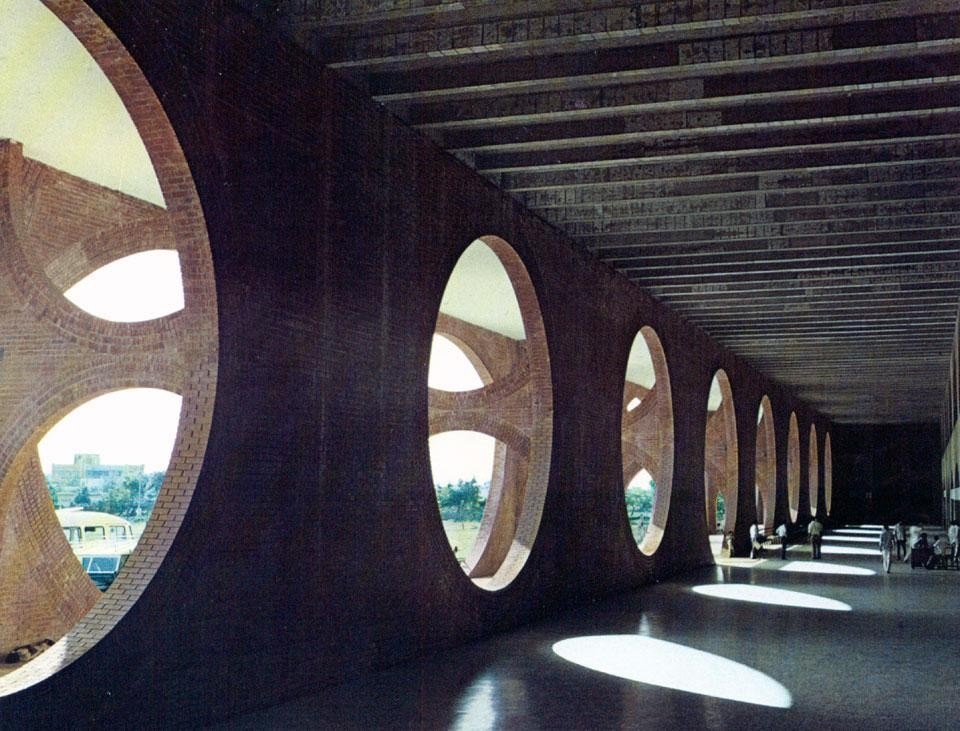It is almost impossible to lock Louis I. Kahn inside a precise historiographical category – capable as he was of pushing the modern toward abstraction and classical sensibility – or geographical – an “American” architect, he was born in Estonia, the international migration of models and debates of his times was the cornerstone of his research. The monumentality of his works, especially those belonging to the full confirmation of his success, such as the Center for British Art at Yale University or the Kimbell Art Museum in Fort Worth, Texas, later confronted by Tadao Ando with a new architecture, expressed in built shapes what could be the public representation of an increasingly less localist and increasingly global collectivity. It was a way of conceiving public architecture that would also characterize the pure shapes, circles, arches and triangles, almost conceptual stereometric masses, of the parliament and hospital buildings for the new Capital of nascent Bangladesh, Dhaka. Kahn died in 1974, while the construction site was open: in July 1975, Domus hosted an exchange on issue 548, between two of the architect’s collaborators and friends, taking us inside the generative process of this last work of global monumentality.
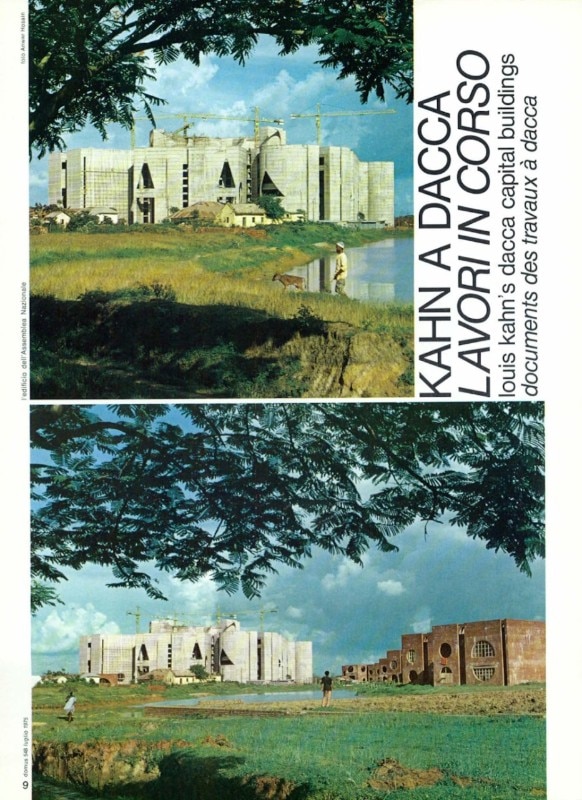
Louis Kahn's Dacca capital buildings
This is a recent photographic record of some of the buildings designed by Louis I. Kahn for Dacca, the capital of East Pakistan. In particular, the National Assembly building and the Ayub central hospital. The drawings and models for these buildings have been famous for ten years. Now Kahn's great forms, these volumes continually pierced by light, are coming into being. And the people of Dacca are beginning to take possession of them both mentally and in practice. With these photographs (which come to us from Anwar Hosain, of the Poona Film Institute, India) we are passing on some of the information on work in progress which we extracted from a talk arranged for Domus in Philadelphia, between two of Kahn's friends and collaborators, Richard Saul Wurman, an architect who is now working on a book of the collected writings and speeches of Louis I. Kahn, and Henry Wilcots, who has worked for Kahn for many years, including a period in Dacca.
Richard Saul Wurman: How much more is there to be built, what part of the total scheme has been started or is at least under way?
Henry Wilcots: What you see on these photographs of Dacca constitutes approximately 90 % of the brickwork that has to be constructed in the first phase, that is, that area around the National Assembly. Of course the National Assembly itself is a concrete building, it's pretty close around 65-70 % completed; and they are forming up for the roof now over the Assembly Chamber itself.
How much different will the final building then look from what we see now? Will it be sheathed in any other material or just look Iike it looks now?
It will look just the way it is looking now, cleaned up a little bit. There is some pointing to be carried out on the brickwork. We will be waiting until all the brick is up; we'll wash it down and then we will finish pointing.
In all the drawings that Lou made as well as in a lot of his conversations, water was a very important part of his schemes. Will there be much water present when the design is completed?
Definitely, the National Assembly is bounded on two sides by a lake, by a man-made lake and this crescent lake, which is also called lunar lake, north of the capital is all but completed. Its northern boundary wall still needs to be completed. There is lighting that goes in on the road side to be completed also.
When was the last time that Lou was in Dacca?
January 1974.
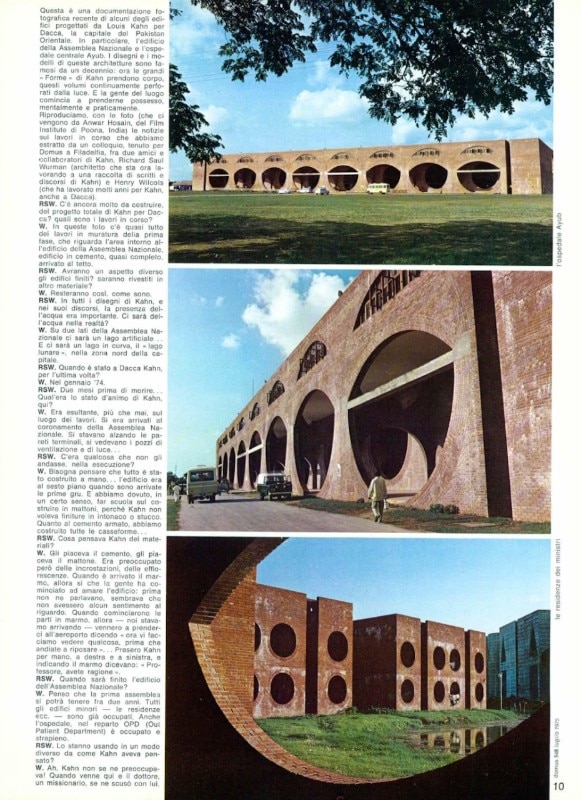
So he was there just before he died, two months before.
We were there together at that time, looking it over and just making a general survey of all the works and also walking over some of the new acrage that the government was going to release for additional building; and, also, we were setting the site for the Secretariat Building, which is in working drawings now.
That is being carried on by the continuation of the office?
Right. What has happened on that is Lou had designed it and we had made our preliminary presentation in January 1974 and from that we were starting all the working drawings. The buildings will be a composite of brick and concrete in character.
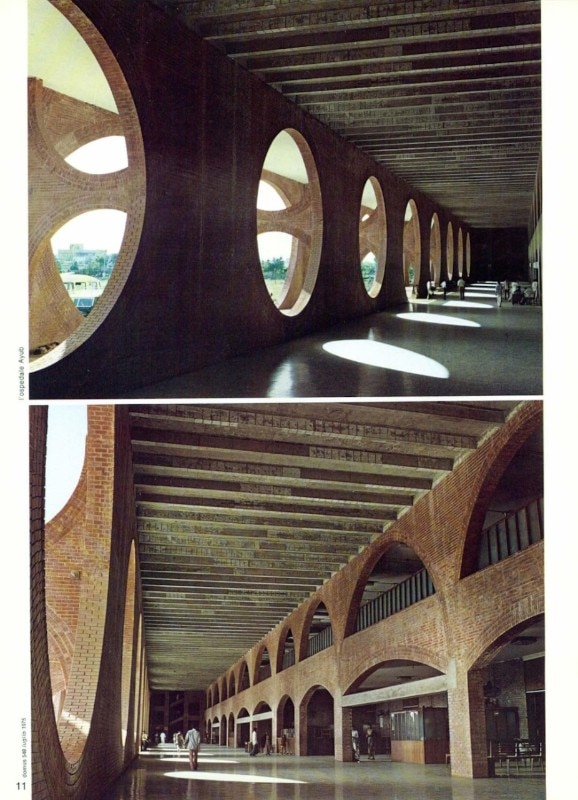
What were Lou's feelings when he was there last time?
He was terribly jubilant and I think it was the best I had seen him on the site. What had taken place is that the crowning of the Assembly had begun. The top walls had started to go up so you could see the air circulating shafts coming down and the light wells and to him he said: "I think it's finished ".
Were there any parts of the scheme that he wasn't so happy with? What did he feel of the workmanship? I have been there and the workmanship leaves much to be desired.
My personal opinion is that every cubic foot of concrete has been touched by some guy's hand and I think you must consider the workmanship from that; the building was up at least six stores before the first cranes arrived. Now we have four of them and I think only three have really ever operated; the first one never did. The brickwork, it was almost a schooling that he conducted on the brickwork, which was the first thing we began and we gathered a lot of material here from the Brick Institute. We carried it over there and we actually began to train people for the brick. Some of it they sort of botched up in some of the houses. They had in mind that it was all going to be plastered or stuccoed and Lou never had this in mind. So they were building for stucco, until we straightened them out on that. The concrete work, we made all the forms, we set up a whole system for that. We even established a wood-working shop at one time over there to build the forms, because we knew just what forms we were after.
My personal opinion is that every cubic foot of concrete has been touched by some guy's hand and I think you must consider the workmanship from that; the building was up at least six stores before the first cranes arrived. Now we have four of them and I think only three have really ever operated; the first one never did
How did Lou feel about the materials?
He liked the concrete; he liked the brick too, but he was worried about the pointing and the effluorescence in the brickwork, he was deeply concerned about that. The concrete, some of it did get a little fouled up, some slippage occurred. As soon as the marble began, then even the people there began to like the building. Up until that time no one really spoke about it, they never seemed to have any feeling toward it, they couldn't relate to it. When the marble began, one of the trips we were out there, and I think it was before the last one, they met us at the airport and said: "we must show you something and then you can go rest ". One at each side they took Lou by his hands and pointed at the marble and they said: "professor, you are right".
What's the anticipation of completing the project now?
I suspect it's going to take another two years before they can really hold a session in the National Assembly building. The hostels are occupied, though there is still some work to do on windows and doors. In the National Assembly itself, other than the roof, the flooring has begun, the interior marble has begun and all the doors and furniture, that is all to do yet. We do have sample furniture over the Assembly Chamber itself, which was constructed over there. Ali the little buildings, residences, they are all occupied now; they have been for several years. On the hospital Itself, the foundations have been in for a good period of time and the OPD, the Out Patients Department, is occupied and overflowing.
The OPD is being used differently from what had been anticipated? How has the use of that changed?
It didn't bother Lou! Actually we were there and the doctor came to him, it was a missionary doctor, and he came to him and apologized for the way he was using the building, knowing that it wasn't used the way Lou had designed it. Lou just laughed with him, they chattered about the whole thing and in the end Lou said: "well, but you are using it? That's what it's for ".
What has changed in its use?
There are great spaces inside. There is an entrance veranda and then a small waiting hall and several corridors within it which have been made as the service corridors and patients corridors and a series of circulation spaces took place in there. They always fought against us, there was too much space being wasted, constantly too much space, they kept telling us and Lou kept telling them: "wait, you'll use it, you'll occupy it all. Something will happen and you'll use all that space". That's what's going on right now. I think that building is a sort of accumulation of all the arch work and all the brickwork; they all came together in this one building and Lou really loved that.
How was this complex treated during the war? Wasn't there fighting or occupation in this area?
There was occupation with it at one time by the Pakistan and another time by the Indian army and the Bangladesh forces; and they sort of all used it as a warehouse, as ammunition depot, as headquarters. Ali sorts of things took place in there, and it was never damaged. The only scar it had was from a plane crash on the steps of the Presidential Square and we saw it by a photograph. When we went out there, they had already repaired it.
How did Lou feel during the war, was he very concerned about it?
Very frightful about the whole thing. We thought it was going to be the first target, because it is placed very close to the airport. There is a story that they told Lou. What happened was that the pilots making the runs over Dacca saw this building and they thought that it had already been bombed, because there were so many holes in it, so they wouldn't waste another bomb on it! We had expected a lot of damage, but the only damage was just misuse and any building would suffer when it is not being used. That's what has happened to it, deterioration in that aspect. There is a lot of cleaning we have to do and Lou was trying to encourage them to clean up the whole site, everything surrounding it should be cleaned up and that is what he was about to do in 1974.
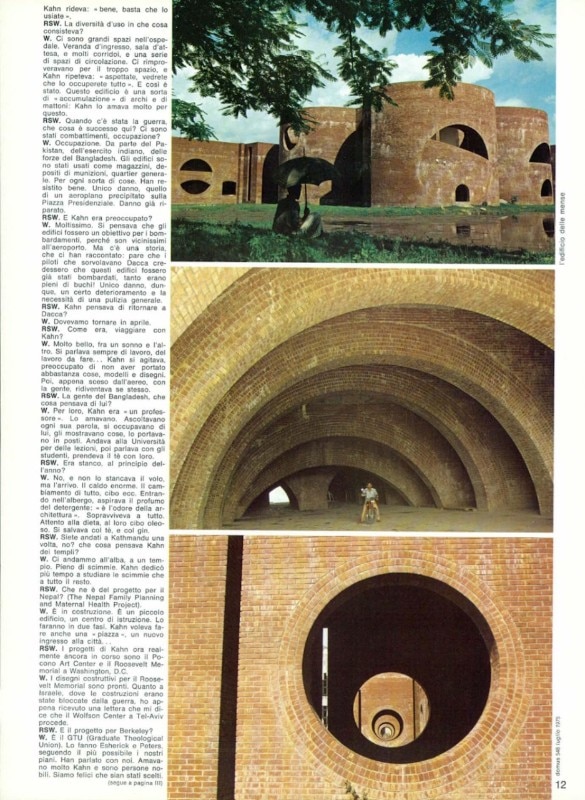
How was it to travel with him?
Oh, it was fun, in between sleeps! We got on the plane and then we would always start some sort of conversation about the office, how things were going. Then we began to talk in a lighter vein and we just travelled that way until we almost reached the site. Many times we talked about things that he had to do, all the work that we must do, and we weren't prepared to go there, he wasn't carrying enough things, we should have this drawing, we should have that model. Ali of these things, he was very concerned until he stepped out of the plane and was met, then he was himself again.
What did the people in Bangladesh think of him, what were their feelings about him?
To them he was a professor and they loved him. They just listened to every word he said, they cared for him, they always wanted to show him things and take him places. He was very glad because he always had enough time to meet the students out there. He would go to the University, they would invite him, he would have a lecture with them, then he would sit and have tea together in some place.
Was he getting very tired in the beginning of the year?
No, he was only tired just on arrival and not so much, I don't think, from the plane ride itself, but from the week he charetted before going, so that he needed a few hours after arrival and going to Dacca it is a long way and it is hot. When you step out the plane the heat is terrible, everything changes, food and so on. Coming into the hotel Lou would always smell this detergent or something like this and say: "oh, it's the smells of architecture, isn't it!" He survived all that. He would watch his diet, until of course he would have to go to some dinner. I think the tea saved him or the gin really.
You went once with him to Kathmandu too: did Lou like it?
Yes, he was fond of the air and the mountains, he was excited as am child when he flew over the mountains.
Did he visit many of the temples?
One morning, very early, our representative there took us up to one of the temples. I didn't think that Lou would go; he went up to the temple, and there are monkeys all over the place. He spent more time studying the monkeys than anything else.
What has happened to the project in Nepal? (The Nepal Family Planning and Maternal Child Health Project).
It is under way; it will take another year; it's under construction. Drawings were done but a year went by before construction started. It is a modest building, very small; it is a training center. It is being built in two phases and the administration phase is under way now.
The projects that are really still under work now are the Pocono Arts Center and the Roosevelt Memorial in Washington D.C.
We just completed the working drawings on the Roosevelt Memorial so that will be under way hopefully. I just received a letter, that looks like the Wolfson Center work in Tel Aviv will be going ahead now. The government (Israeli) had put a clamp on all construction because of the war effort.
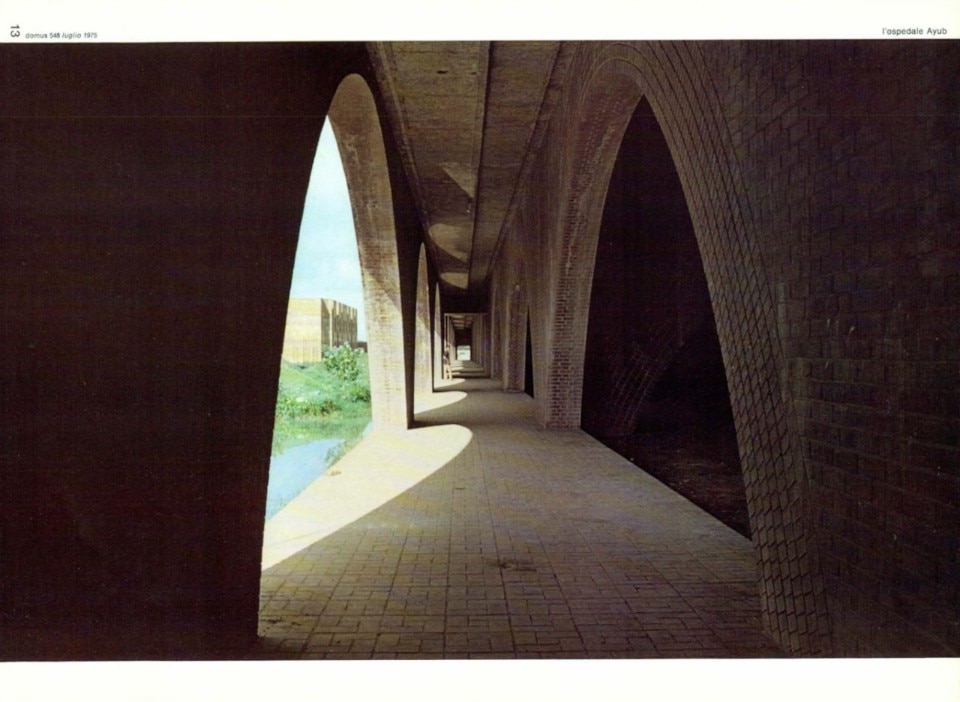
What about the Berkeley, California, Project? Are they trying to follow Lou's plans or what?
Esherick and Peters are doing that and they came in going through the drawings and just talking to us in general about it. They are going to try and follow the plan as much as possible. They both liked Lou very much, too. They are both very noble guys; we were very happy that they were chosen. The name of that project is GTU, it is the Graduate Theological Union.
In the Dacca Project, is there going to be a lot of planting? What will be the character of the landscape?
There is going to be a good deal of planting, but not nearly as much as Lou had first envisaged. He changed his mind. During all these years he has been going out here and once the building was up and the bamboo was off of it, he looked at the Presidential Square and he said: "no trees". So the trees will be on the road, in circulatory ways, but in front of the National Assembly there will be just a large grass area. On the south side it will be tree lined. That will be a landscaped garden area, because there are no buildings out there anymore. We had a secretariat there before, and when the new government came in the secretariat was shifted. It needed more space, it was a larger building, four times as large, so that all buildings were removed and only promenade places were kept. That's what the south side is going to be now. That was his last master plan.


